Suman Saha
Leveraging LLM to Strengthen ML-Based Cross-Site Scripting Detection
Apr 28, 2025Abstract:According to the Open Web Application Security Project (OWASP), Cross-Site Scripting (XSS) is a critical security vulnerability. Despite decades of research, XSS remains among the top 10 security vulnerabilities. Researchers have proposed various techniques to protect systems from XSS attacks, with machine learning (ML) being one of the most widely used methods. An ML model is trained on a dataset to identify potential XSS threats, making its effectiveness highly dependent on the size and diversity of the training data. A variation of XSS is obfuscated XSS, where attackers apply obfuscation techniques to alter the code's structure, making it challenging for security systems to detect its malicious intent. Our study's random forest model was trained on traditional (non-obfuscated) XSS data achieved 99.8% accuracy. However, when tested against obfuscated XSS samples, accuracy dropped to 81.9%, underscoring the importance of training ML models with obfuscated data to improve their effectiveness in detecting XSS attacks. A significant challenge is to generate highly complex obfuscated code despite the availability of several public tools. These tools can only produce obfuscation up to certain levels of complexity. In our proposed system, we fine-tune a Large Language Model (LLM) to generate complex obfuscated XSS payloads automatically. By transforming original XSS samples into diverse obfuscated variants, we create challenging training data for ML model evaluation. Our approach achieved a 99.5% accuracy rate with the obfuscated dataset. We also found that the obfuscated samples generated by the LLMs were 28.1% more complex than those created by other tools, significantly improving the model's ability to handle advanced XSS attacks and making it more effective for real-world application security.
GEM: A Generalizable Ego-Vision Multimodal World Model for Fine-Grained Ego-Motion, Object Dynamics, and Scene Composition Control
Dec 15, 2024



Abstract:We present GEM, a Generalizable Ego-vision Multimodal world model that predicts future frames using a reference frame, sparse features, human poses, and ego-trajectories. Hence, our model has precise control over object dynamics, ego-agent motion and human poses. GEM generates paired RGB and depth outputs for richer spatial understanding. We introduce autoregressive noise schedules to enable stable long-horizon generations. Our dataset is comprised of 4000+ hours of multimodal data across domains like autonomous driving, egocentric human activities, and drone flights. Pseudo-labels are used to get depth maps, ego-trajectories, and human poses. We use a comprehensive evaluation framework, including a new Control of Object Manipulation (COM) metric, to assess controllability. Experiments show GEM excels at generating diverse, controllable scenarios and temporal consistency over long generations. Code, models, and datasets are fully open-sourced.
Language-Guided Instance-Aware Domain-Adaptive Panoptic Segmentation
Apr 04, 2024

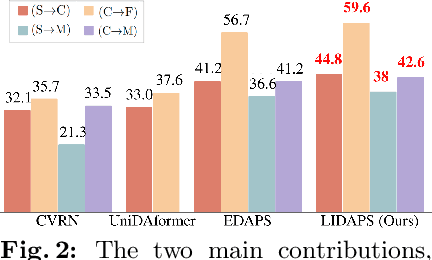
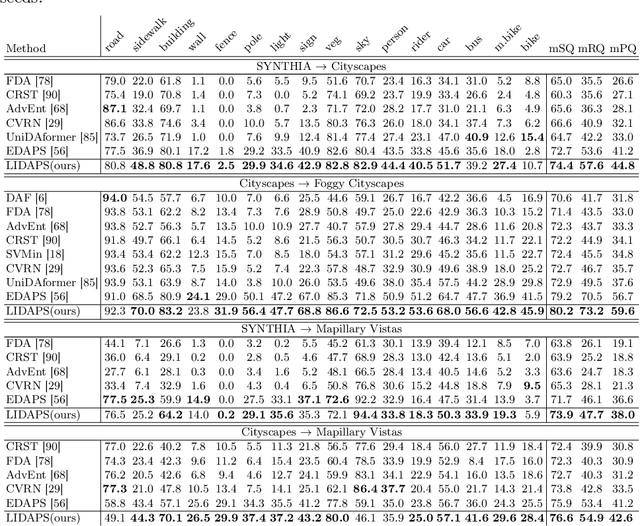
Abstract:The increasing relevance of panoptic segmentation is tied to the advancements in autonomous driving and AR/VR applications. However, the deployment of such models has been limited due to the expensive nature of dense data annotation, giving rise to unsupervised domain adaptation (UDA). A key challenge in panoptic UDA is reducing the domain gap between a labeled source and an unlabeled target domain while harmonizing the subtasks of semantic and instance segmentation to limit catastrophic interference. While considerable progress has been achieved, existing approaches mainly focus on the adaptation of semantic segmentation. In this work, we focus on incorporating instance-level adaptation via a novel instance-aware cross-domain mixing strategy IMix. IMix significantly enhances the panoptic quality by improving instance segmentation performance. Specifically, we propose inserting high-confidence predicted instances from the target domain onto source images, retaining the exhaustiveness of the resulting pseudo-labels while reducing the injected confirmation bias. Nevertheless, such an enhancement comes at the cost of degraded semantic performance, attributed to catastrophic forgetting. To mitigate this issue, we regularize our semantic branch by employing CLIP-based domain alignment (CDA), exploiting the domain-robustness of natural language prompts. Finally, we present an end-to-end model incorporating these two mechanisms called LIDAPS, achieving state-of-the-art results on all popular panoptic UDA benchmarks.
Three Ways to Improve Verbo-visual Fusion for Dense 3D Visual Grounding
Sep 08, 2023Abstract:3D visual grounding is the task of localizing the object in a 3D scene which is referred by a description in natural language. With a wide range of applications ranging from autonomous indoor robotics to AR/VR, the task has recently risen in popularity. A common formulation to tackle 3D visual grounding is grounding-by-detection, where localization is done via bounding boxes. However, for real-life applications that require physical interactions, a bounding box insufficiently describes the geometry of an object. We therefore tackle the problem of dense 3D visual grounding, i.e. referral-based 3D instance segmentation. We propose a dense 3D grounding network ConcreteNet, featuring three novel stand-alone modules which aim to improve grounding performance for challenging repetitive instances, i.e. instances with distractors of the same semantic class. First, we introduce a bottom-up attentive fusion module that aims to disambiguate inter-instance relational cues, next we construct a contrastive training scheme to induce separation in the latent space, and finally we resolve view-dependent utterances via a learned global camera token. ConcreteNet ranks 1st on the challenging ScanRefer online benchmark by a considerable +9.43% accuracy at 50% IoU and has won the ICCV 3rd Workshop on Language for 3D Scenes "3D Object Localization" challenge.
CS-Mixer: A Cross-Scale Vision MLP Model with Spatial-Channel Mixing
Aug 25, 2023Abstract:Despite their simpler information fusion designs compared with Vision Transformers and Convolutional Neural Networks, Vision MLP architectures have demonstrated strong performance and high data efficiency in recent research. However, existing works such as CycleMLP and Vision Permutator typically model spatial information in equal-size spatial regions and do not consider cross-scale spatial interactions. Further, their token mixers only model 1- or 2-axis correlations, avoiding 3-axis spatial-channel mixing due to its computational demands. We therefore propose CS-Mixer, a hierarchical Vision MLP that learns dynamic low-rank transformations for spatial-channel mixing through cross-scale local and global aggregation. The proposed methodology achieves competitive results on popular image recognition benchmarks without incurring substantially more compute. Our largest model, CS-Mixer-L, reaches 83.2% top-1 accuracy on ImageNet-1k with 13.7 GFLOPs and 94 M parameters.
EDAPS: Enhanced Domain-Adaptive Panoptic Segmentation
Apr 27, 2023



Abstract:With autonomous industries on the rise, domain adaptation of the visual perception stack is an important research direction due to the cost savings promise. Much prior art was dedicated to domain-adaptive semantic segmentation in the synthetic-to-real context. Despite being a crucial output of the perception stack, panoptic segmentation has been largely overlooked by the domain adaptation community. Therefore, we revisit well-performing domain adaptation strategies from other fields, adapt them to panoptic segmentation, and show that they can effectively enhance panoptic domain adaptation. Further, we study the panoptic network design and propose a novel architecture (EDAPS) designed explicitly for domain-adaptive panoptic segmentation. It uses a shared, domain-robust transformer encoder to facilitate the joint adaptation of semantic and instance features, but task-specific decoders tailored for the specific requirements of both domain-adaptive semantic and instance segmentation. As a result, the performance gap seen in challenging panoptic benchmarks is substantially narrowed. EDAPS significantly improves the state-of-the-art performance for panoptic segmentation UDA by a large margin of 25% on SYNTHIA-to-Cityscapes and even 72% on the more challenging SYNTHIA-to-Mapillary Vistas. The implementation is available at https://github.com/susaha/edaps.
Exploiting Instance-based Mixed Sampling via Auxiliary Source Domain Supervision for Domain-adaptive Action Detection
Oct 06, 2022



Abstract:We propose a novel domain adaptive action detection approach and a new adaptation protocol that leverages the recent advancements in image-level unsupervised domain adaptation (UDA) techniques and handle vagaries of instance-level video data. Self-training combined with cross-domain mixed sampling has shown remarkable performance gain in semantic segmentation in UDA (unsupervised domain adaptation) context. Motivated by this fact, we propose an approach for human action detection in videos that transfers knowledge from the source domain (annotated dataset) to the target domain (unannotated dataset) using mixed sampling and pseudo-label-based selftraining. The existing UDA techniques follow a ClassMix algorithm for semantic segmentation. However, simply adopting ClassMix for action detection does not work, mainly because these are two entirely different problems, i.e., pixel-label classification vs. instance-label detection. To tackle this, we propose a novel action instance mixed sampling technique that combines information across domains based on action instances instead of action classes. Moreover, we propose a new UDA training protocol that addresses the long-tail sample distribution and domain shift problem by using supervision from an auxiliary source domain (ASD). For the ASD, we propose a new action detection dataset with dense frame-level annotations. We name our proposed framework as domain-adaptive action instance mixing (DA-AIM). We demonstrate that DA-AIM consistently outperforms prior works on challenging domain adaptation benchmarks. The source code is available at https://github.com/wwwfan628/DA-AIM.
Spatio-Temporal Action Detection Under Large Motion
Sep 06, 2022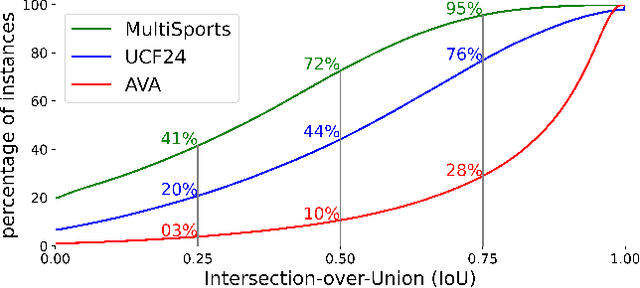
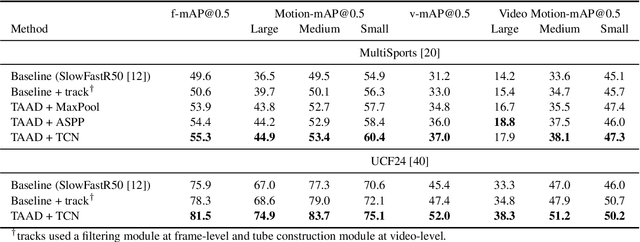

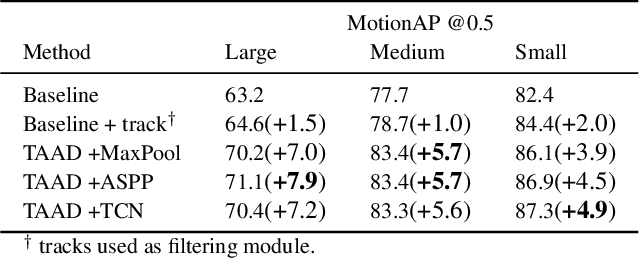
Abstract:Current methods for spatiotemporal action tube detection often extend a bounding box proposal at a given keyframe into a 3D temporal cuboid and pool features from nearby frames. However, such pooling fails to accumulate meaningful spatiotemporal features if the position or shape of the actor shows large 2D motion and variability through the frames, due to large camera motion, large actor shape deformation, fast actor action and so on. In this work, we aim to study the performance of cuboid-aware feature aggregation in action detection under large action. Further, we propose to enhance actor feature representation under large motion by tracking actors and performing temporal feature aggregation along the respective tracks. We define the actor motion with intersection-over-union (IoU) between the boxes of action tubes/tracks at various fixed time scales. The action having a large motion would result in lower IoU over time, and slower actions would maintain higher IoU. We find that track-aware feature aggregation consistently achieves a large improvement in action detection performance, especially for actions under large motion compared to the cuboid-aware baseline. As a result, we also report state-of-the-art on the large-scale MultiSports dataset.
Unsupervised Compound Domain Adaptation for Face Anti-Spoofing
May 18, 2021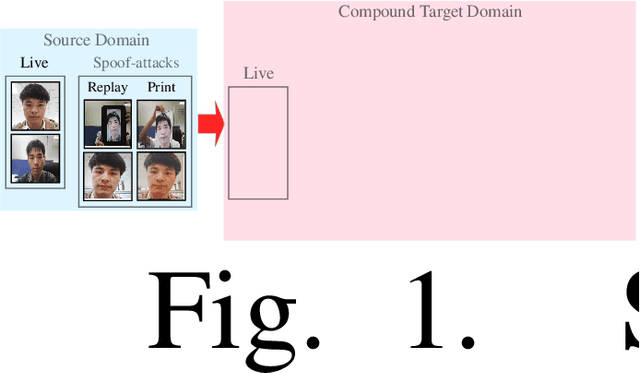
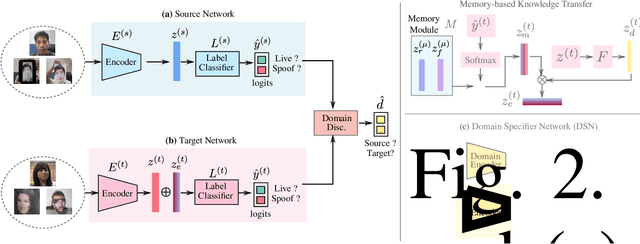
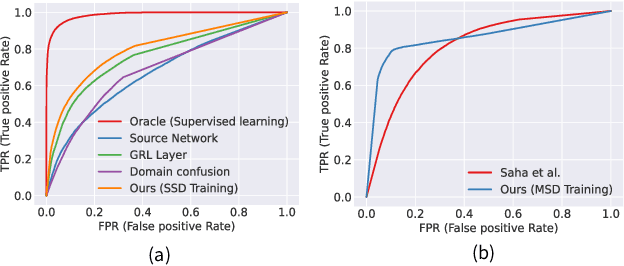

Abstract:We address the problem of face anti-spoofing which aims to make the face verification systems robust in the real world settings. The context of detecting live vs. spoofed face images may differ significantly in the target domain, when compared to that of labeled source domain where the model is trained. Such difference may be caused due to new and unknown spoof types, illumination conditions, scene backgrounds, among many others. These varieties of differences make the target a compound domain, thus calling for the problem of the unsupervised compound domain adaptation. We demonstrate the effectiveness of the compound domain assumption for the task of face anti-spoofing, for the first time in this work. To this end, we propose a memory augmentation method for adapting the source model to the target domain in a domain aware manner. The adaptation process is further improved by using the curriculum learning and the domain agnostic source network training approaches. The proposed method successfully adapts to the compound target domain consisting multiple new spoof types. Our experiments on multiple benchmark datasets demonstrate the superiority of the proposed method over the state-of-the-art.
Learning to Relate Depth and Semantics for Unsupervised Domain Adaptation
May 17, 2021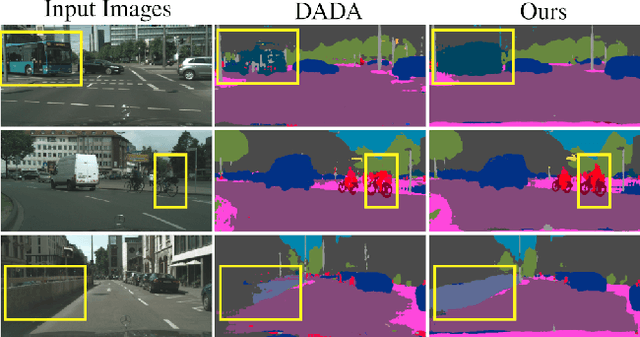


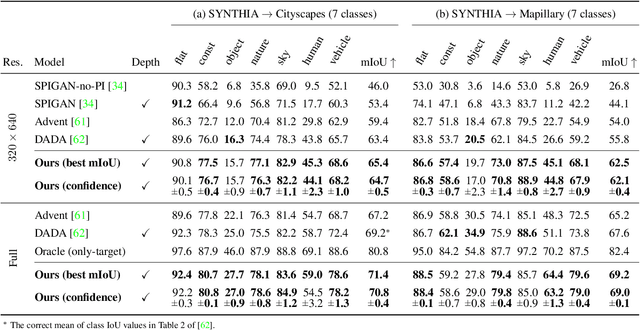
Abstract:We present an approach for encoding visual task relationships to improve model performance in an Unsupervised Domain Adaptation (UDA) setting. Semantic segmentation and monocular depth estimation are shown to be complementary tasks; in a multi-task learning setting, a proper encoding of their relationships can further improve performance on both tasks. Motivated by this observation, we propose a novel Cross-Task Relation Layer (CTRL), which encodes task dependencies between the semantic and depth predictions. To capture the cross-task relationships, we propose a neural network architecture that contains task-specific and cross-task refinement heads. Furthermore, we propose an Iterative Self-Learning (ISL) training scheme, which exploits semantic pseudo-labels to provide extra supervision on the target domain. We experimentally observe improvements in both tasks' performance because the complementary information present in these tasks is better captured. Specifically, we show that: (1) our approach improves performance on all tasks when they are complementary and mutually dependent; (2) the CTRL helps to improve both semantic segmentation and depth estimation tasks performance in the challenging UDA setting; (3) the proposed ISL training scheme further improves the semantic segmentation performance. The implementation is available at https://github.com/susaha/ctrl-uda.
 Add to Chrome
Add to Chrome Add to Firefox
Add to Firefox Add to Edge
Add to Edge